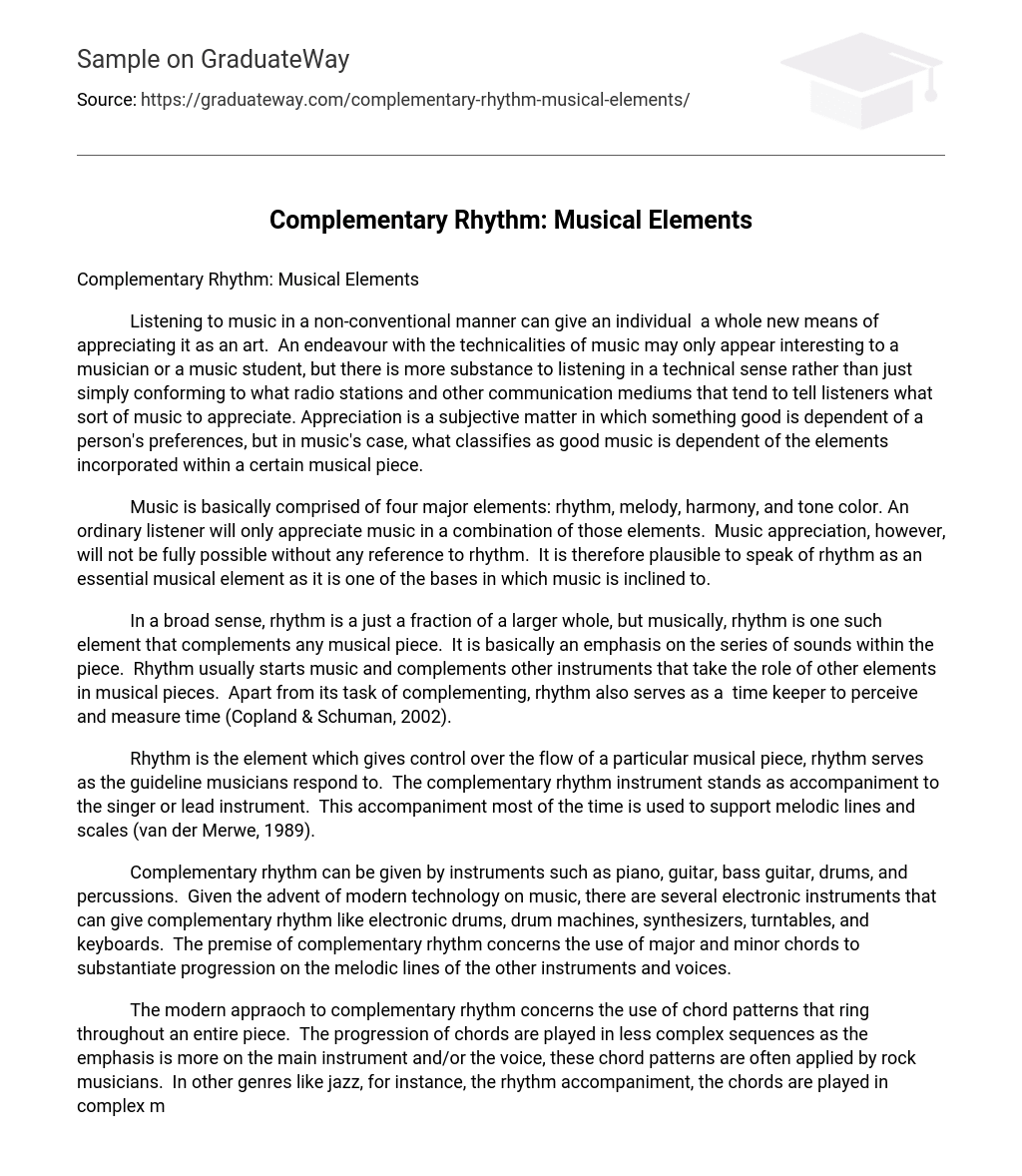Listening to music in a non-conventional manner can give an individual a whole new means of appreciating it as an art. While the technicalities of music may only appear interesting to musicians or music students, there is more substance to listening in a technical sense rather than simply conforming to what radio stations and other communication mediums tell listeners to appreciate. Appreciation is subjective, with something good dependent on a person’s preferences. However, in music’s case, what classifies as good music depends on the elements incorporated within a certain musical piece.
Music is composed of four major elements: rhythm, melody, harmony, and tone color. A combination of these elements is what an ordinary listener appreciates in music. However, music appreciation cannot be complete without considering rhythm. Therefore, it is reasonable to regard rhythm as an essential musical element since it forms one of the bases on which music is built.
In a broad sense, rhythm is just a fraction of a larger whole. However, in music, it is an essential element that complements any musical piece. It emphasizes the series of sounds within the piece and usually starts the music while complementing other instruments that take on other roles in musical pieces. Rhythm not only complements but also serves as a timekeeper to perceive and measure time (Copland & Schuman, 2002).
Rhythm is the element that gives control over the flow of a particular musical piece. It serves as the guideline to which musicians respond. The complementary rhythm instrument stands as an accompaniment to the singer or lead instrument, supporting melodic lines and scales (van der Merwe, 1989).
Complementary rhythm can be provided by instruments such as the piano, guitar, bass guitar, drums, and percussion. With the advent of modern technology in music, several electronic instruments can also provide complementary rhythm like electronic drums, drum machines, synthesizers, turntables and keyboards. The premise of complementary rhythm involves using major and minor chords to support the progression on the melodic lines of other instruments and voices.
The modern approach to complementary rhythm involves using chord patterns that ring throughout an entire piece. The progression of chords is played in less complex sequences, with emphasis placed on the main instrument and/or voice. These chord patterns are often utilized by rock musicians. In other genres, such as jazz, the rhythm accompaniment involves playing chords in more complex manners.
In complementary rhythm, musicians often choose a thicker and stronger sound to emphasize rhythm over the distinct sounds of lead instrumentalists or singers. They use different amplifiers to achieve a flawless rhythm feel and create a sound that differs from that of the lead instrument.
One good musical piece that exercises extensive complementary rhythmic elements can be heard in Ludwig van Beethoven’s Symphony no. 5. The composition’s introduction conforms to the pattern of the four-note format, and the entire piece is taken from the key of C minor (Beethoven, 2005). Beethoven’s fifth symphony provides a harmony of tonal movement, but rhythm is more prevalent. Symphony number 5 uses single chord notes, and less melodic sound can be heard from it (Beethoven, 2005).
Wolfgang Amadeus Mozart’s Eine kleine Nachtmusik is an exemplary piece of complementary rhythm. The composition was written in 1787 while Mozart was busy working on the opera Don Giovanni. The original arrangement consists of two violins, viola, cello, and double bass, but contemporary versions use more instruments (Zaslaw & Cowdert, 1991). The piece begins with a melodic flow that progresses into a more rhythmic one. The first theme recurs throughout the piece and is overlapped by a thicker third theme in the key of C minor, although the prevailing sound comes from the key of C major (Mozart, 1787).
Modern compositions often feature complementary rhythms in their songs, such as Led Zeppelin’s 1969 track Whole Lotta Love.” The song starts with a guitar riff in the key of E major that continues throughout. This rhythm-heavy approach is a significant departure from Jimmy Page’s typically melody-focused style. While Robert Plant’s high-pitched vocals provide the main melody, it is the complementary rhythm that gives the song its unique feel (Page, Plant, Bonham, Jones & Dixon, 1969).
References
Beethoven, L. (1804). Symphony No. 5 [Recorded by Milwaukee Symphony Orchestra]. On Beethoven: Symphony No. 5 [MP3]. Milwaukee: MSO Classics, (2005).
Copland, A. and Schuman, W. (2002). What to Listen for in Music. New York: Signet Classics.
Mozart, W.A. (1787). Eine kleine Nachtmusik [Capella Istropolitana]. On The Best of Mozart [CD]. Franklin, WI: Naxos, (1998).
Page, J., Plant, R., Bonham, J., Jones, J. & Dixon, W. (1969). Whole Lotta Love. On Mothership [CD]. New York: Atlantic Records, (2007).
Van der Merwe, P. (1989). Origins of the Popular Style: The Antecedents of Twentieth-Century Popular Music. Oxford: Clarendon Press.
Zeslaw, N. and Cowdery, W. (1991) The Compleat Mozart: A Guide to the Musical Works of Wolfgang Amadeus Mozart. New York: Norton.





